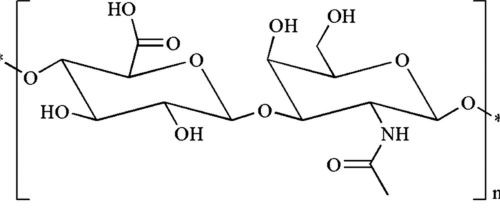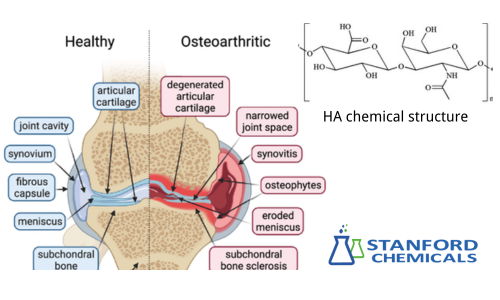
As we all know, Hyaluronic acid is known for its skincare and moisturizing benefits, but it’s also a key treatment for osteoarthritis. How exactly does it work? This article will delve into the details.
What is Hyaluronic Acid
Hyaluronic acid is one of the naturally occurring substances in the human body, found in huge amounts in the skin, joints, and eyes. This has very good moisturizing and lubricating properties and is hence widely applied in skincare and health treatments.
–Health Benefits of Hyaluronic Acid:
- Hydration: Hyaluronic acid absorbs and holds lots of moisture within itself, thus keeping the skin soft and hydrated.
- Joint Support: It relieves pain and stiffness in joints and helps regain the functionality of joints.
- Wound Healing: HA hastens wound healing by reducing inflammation and increasing cell regeneration rate.
- Skin Elasticity: Improve skin elasticity so that it does not sag and look older.
- Eye Health: HA can be used in mitigating dry eyes and other types of eye discomforts.

How Hyaluronic Acid Relieves Osteoarthritis
Hyaluronic acid can alleviate symptoms of osteoarthritis, particularly in patients in an early to middle stage of the disease.
–Role of Hyaluronic Acid in Joints
Hyaluronic acid plays a crucial role in joint health through its lubrication and cushioning action that enables the joints to move smoothly. As one of the important components of synovial fluid, its viscosity and lubricating features, shared with hyaluronic acid, reduce friction between the surfaces of the joints, thus protecting the cartilage from wear and tear.
Joints, upon movement, are subjected to pressure and shock. The viscoelastic attributes of hyaluronic acid make it possible to absorb and distribute these forces, which otherwise would cause damage to the joints.
HA provides important nutrients to cartilage and helps to lock in the natural moisture present in cartilage, which is of vital importance to its suppleness and elasticity, thereby avoiding degeneration.
In inflammatory joint diseases, hyaluronic acid reduces the release of inflammatory mediators and thus does lighten one of the prominent symptoms of osteoarthritis, which is joint pain with inflammation. Intra-articular injections of HA are often used to treat osteoarthritis by improving the functional ability of joints and alleviating symptoms of the disease.

–Role of Hyaluronic Acid in Bones
It will also aid in bone health maintenance and support for overall integrity. While HA is abundant in cartilage and joint fluid, it resides in bone tissue as well. Among the roles it plays are:
- Bone Health Support: HA allows the bone tissue to maintain elasticity and toughness; this HA regulates the water content in the bone matrix so that the bones don’t turn brittle.
- Promotion of Bone Repair: During the healing process of fractures or other damage to the bone, HA stimulates the activity of osteoblasts involved in the regeneration and repair of bone.
- Anti-Inflammatory Effects: With respect to its anti-inflammatory properties, HA should be able to reduce bone-related inflammation and hence relieve bone pain and discomfort related to inflammatory conditions.
Conclusion
In this regard, hyaluronic acid is an asset for the management of osteoarthritis and bone health. Hyaluronic acid acts as a lubricant in joints, provides nourishment to cartilage, and is anti-inflammatory. Thus, in various ailments relating to joints and bones, it becomes very much of use. Since it is a natural substance, hyaluronic acid is a safe and effective substance for those seeking relief from the misery brought about by osteoarthritis and other related disorders.
Stanford Chemical Company (SCC) is a trusted supplier of sodium hyaluronate powder. We provide customers with high-purity, non-animal-derived, non-GMO hyaluronic acid powder (including food grade, cosmetic grade, injection grade, medical grade, eye drop grade, cross-linked gel). Enjoy bulk purchase discounts and contract pricing.
FAQs
1. How is hyaluronic acid administered for arthritis?
Hyaluronic acid is typically administered through injections directly into the affected joint.
2. How long does it take for hyaluronic acid injections to work?
The effects of HA injections can vary, but many patients start to notice improvement in pain and joint function within a few weeks after the treatment. The relief can last for several months, depending on the severity of the arthritis.
3. Are there any side effects of hyaluronic acid injections for arthritis?
HA injections are generally well-tolerated, but some patients may experience mild side effects such as swelling, redness, or discomfort at the injection site. These symptoms are usually temporary and resolve on their own.
4. Can hyaluronic acid cure arthritis?
While sodium hyaluronate can effectively manage symptoms and improve joint function, it does not cure arthritis. The treatment is designed to relieve pain and stiffness, making it easier to perform daily activities, but it cannot reverse the underlying joint damage.
